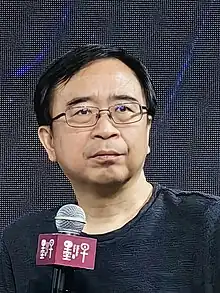Pan Jianwei
Pan Jianwei (Chinese: 潘建伟; pinyin: Pān Jiànwěi; born 11 March 1970) is a Chinese academic administrator and quantum physicist. He is a university administrator and professor of physics at the University of Science and Technology of China. Pan is known for his work in the field of quantum entanglement, quantum information and quantum computers. In 2017, he was named one of Nature's 10, which labelled him "Father of Quantum".[5] He is an academician of the Chinese Academy of Sciences and the World Academy of Sciences and Executive Vice President of the University of Science and Technology of China.[6] He also serves as one of the Vice Chairman of Jiusan Society.[7]
Pan Jianwei | |
|---|---|
潘建伟 | |
 | |
| Born | 11 March 1970 |
| Title | Professor and Executive Vice President of the University of Science and Technology of China Vice Chairman of Jiusan Society |
| Alma mater | USTC University of Vienna |
| Known for | Multi-photon quantum entanglement Free-space quantum teleportation Quantum computer |
| Awards | Erich Schmid Prize (2003)[1] Emmy Noether Research Award (2004) Sofja Kovalevskaja Award (2004)[1] Fresnel Prize (2005)[1] Chinese Young Scientist Prize (2006) [1] QCMC Quantum Communication Award (2012)[2] Physics World 2015 Breakthrough of the Year [3] 2015 State Natural Science Award (First Class)[4] 2018 Willis E. Lamb Award for Laser Science and Quantum Optics Micius Quantum Prize (2019) ZEISS Research Award (2020) |
| Scientific career | |
| Fields | Quantum mechanics |
| Institutions | University of Science and Technology of China |
| Doctoral advisor | Anton Zeilinger |
Early life and education
Pan was born in Dongyang, Jinhua, Zhejiang province in 1970. In 1987, he entered the University of Science and Technology of China (USTC), from which he received his bachelor's and master's degrees. He received his PhD from the University of Vienna in Austria, where he studied and worked in the group led by Nobel prize winning physicist Anton Zeilinger.[1]
Contributions
Pan's team demonstrated five-photon entanglement in 2004.[8] Under his leadership, the world's first quantum satellite launched successfully in August 2016 as part of the Quantum Experiments at Space Scale, a Chinese research project.[9][10] In June 2017, Pan's team used their quantum satellite to demonstrate entanglement with satellite-to-ground total summed lengths between 1600km and 2400km and entanglement distribution over 1200km between receiver stations.[11]
In 2021, Pan led a team which built quantum computers. One of the devices, named "Zuchongzhi 2.1", was claimed to be one million times faster than its nearest competitor, Google's Sycamore.[12]
Awards and recognition
Pan was elected to the Chinese Academy of Sciences in 2011 at the age of 41, making him one of the youngest CAS academicians.[13] He was then elected to the World Academy of Sciences in 2012 and won the International Quantum Communication Award in the same year.[14]
In April 2014, he was appointed Vice President of the University of Science and Technology of China.
His team's work on double quantum-teleportation was selected as the Physics World "Top Breakthrough of the Year" in 2015.[3] His team, whose members include Peng Chengzhi, Chen Yu'ao, Lu Chaoyang, and Chen Zengbing, won the State Natural Science Award (First Class) in 2015.[4]
In 2017, the journal Nature named Pan, along with such figures as Ann Olivarius and Scott Pruitt, one of the top 10 people who made "a significant impact in science either for good or for bad", with the label "Father of Quantum" given to Pan.[5]
Pan was included in Time magazine's 100 Most Influential People of 2018.[15]
In 2019, Pan was appointed as lead editor of Physical Review Research.[16]
In 2020, Pan received the ZEISS Research Award.[17]
References
- "Jian-Wei Pan". University of Science and Technology of China. Retrieved 2019-09-15.
- "Quantum Communication Award 2012". 2012-07-30. Retrieved 2019-09-15.
- "Double quantum-teleportation milestone is Physics World 2015 Breakthrough of the Year - physicsworld.com". physicsworld.com. 2015-12-11. Retrieved 2019-09-15.
- "The 2015 State Nature Science First Class Award honors USTC team's work". en.hfnl.ustc.edu.cn. Retrieved 2019-09-15.
- Elizabeth Gibney. "Nature's 10". Retrieved 2019-09-15.
- "潘建伟-中国科学技术大学" (in Chinese). Retrieved 2020-10-21.
- "潘建伟副主席_九三学社中央委员会" (in Chinese). Retrieved 2020-10-20.
- Zhao Z, Chen YA, Zhang AN, Yang T, Briegel HJ, Pan JW (July 2004). "Experimental demonstration of five-photon entanglement and open-destination teleportation". Nature. 430 (6995): 54–8. arXiv:quant-ph/0402096. Bibcode:2004Natur.430...54Z. doi:10.1038/nature02643. PMID 15229594. S2CID 4336020.
- Nomaan Merchant (2016-08-16). "China's launch of quantum satellite major step in space race". Retrieved 2019-09-15.
- Aron, Jacob (2016-08-16). "China launches world's first quantum communications satellite". Retrieved 2019-09-15.
- J. Yin, Y. Cao, Y.- H. Li, S.- K. Liao, L. Zhang, J.- G. Ren, W.- Q. Cai, W.- Y. Liu, B. Li, H. Dai, G.- B. Li, Q.- M. Lu, Y.- H. Gong, Y. Xu, S.- L. Li, F.- Z. Li, Y.- Y. Yin, Z.- Q. Jiang, M. Li, J.- J. Jia, G. Ren, D. He, Y.- L. Zhou, X.- X. Zhang, N. Wang, X. Chang, Z.- C. Zhu, N.- L. Liu, Y.- Ao. Chen, C.- Y. Lu, R. Shu, C.- Z. Peng, J.- Y. Wang, and J.- W. Pan "Satellite-based entanglement distribution over 1200 kilometers", Science, 356, 6343, 1140-1144, (2017) doi:10.1126/science.aan3211
- "China builds world's fastest programmable quantum computers". Independent.co.uk. 31 October 2021. Archived from the original on 2022-05-24.
- "41岁潘建伟教授当选最年轻中国科学院院士". sias.ustc.edu.cn. Retrieved 2 May 2022.
- Mason Coultrane (2015-02-06). "Quantum Communication Takes Another Leap Between Beijing and Shanghai". Yibada. Retrieved 2019-09-15.
- "Jian-Wei Pan: The World's 100 Most Influential People". Time. Retrieved 2020-09-22.
- "Jian-Wei Pan Appointed Lead Editor of Physical Review Research". American Physical Society. 2019-06-11. Retrieved 2019-09-15.
- "Jian-Wei Pan to Receive ZEISS Research Award". 2020-04-20. Retrieved 2020-10-20.